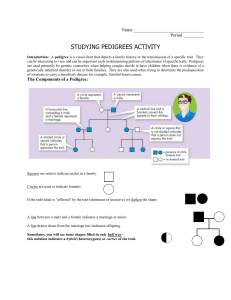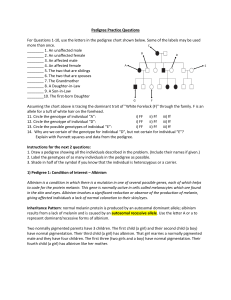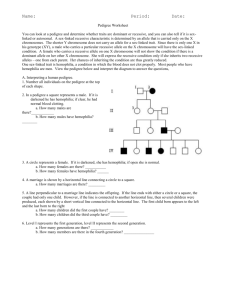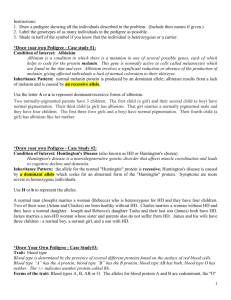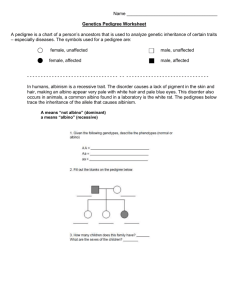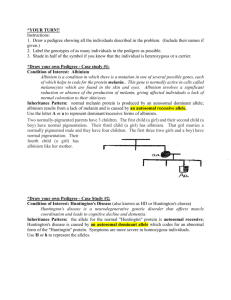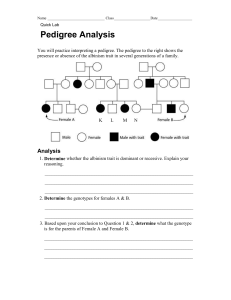Human Pedigrees Worksheet: Genetics & Inheritance
advertisement
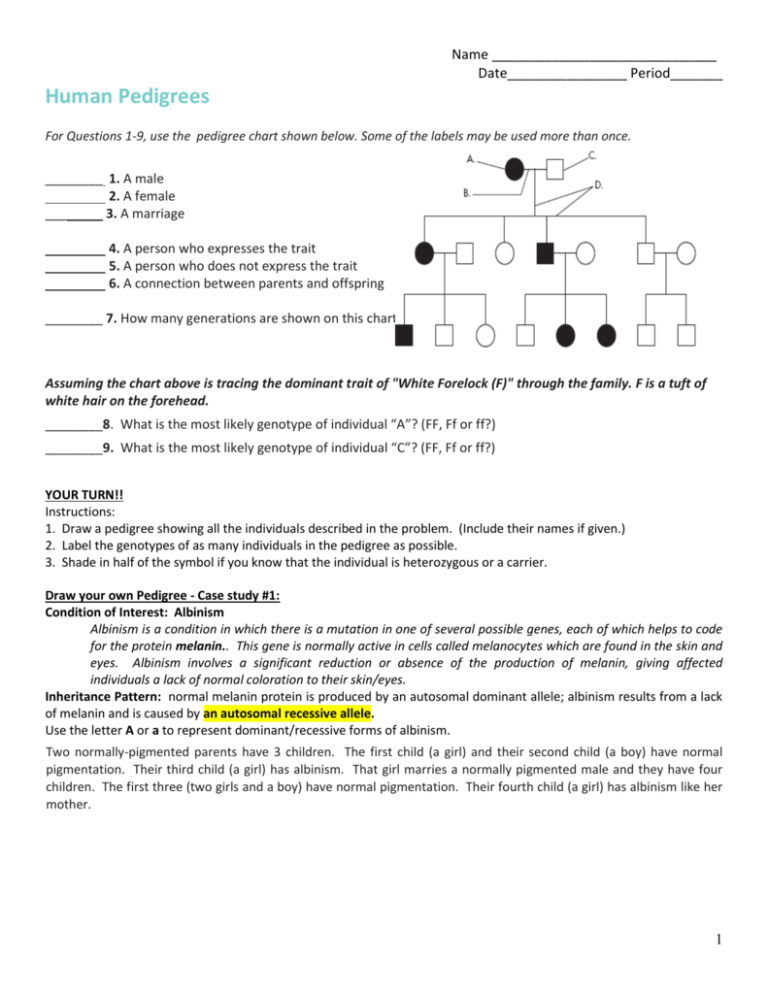
Name ______________________________ Date________________ Period_______ Human Pedigrees For Questions 1-9, use the pedigree chart shown below. Some of the labels may be used more than once. ________ 1. A male 2. A female ________ 3. A marriage 4. A person who expresses the trait 5. A person who does not express the trait 6. A connection between parents and offspring ________ 7. How many generations are shown on this chart? Assuming the chart above is tracing the dominant trait of "White Forelock (F)" through the family. F is a tuft of white hair on the forehead. ________8. What is the most likely genotype of individual “A”? (FF, Ff or ff?) ________9. What is the most likely genotype of individual “C”? (FF, Ff or ff?) YOUR TURN!! Instructions: 1. Draw a pedigree showing all the individuals described in the problem. (Include their names if given.) 2. Label the genotypes of as many individuals in the pedigree as possible. 3. Shade in half of the symbol if you know that the individual is heterozygous or a carrier. Draw your own Pedigree - Case study #1: Condition of Interest: Albinism Albinism is a condition in which there is a mutation in one of several possible genes, each of which helps to code for the protein melanin.. This gene is normally active in cells called melanocytes which are found in the skin and eyes. Albinism involves a significant reduction or absence of the production of melanin, giving affected individuals a lack of normal coloration to their skin/eyes. Inheritance Pattern: normal melanin protein is produced by an autosomal dominant allele; albinism results from a lack of melanin and is caused by an autosomal recessive allele. Use the letter A or a to represent dominant/recessive forms of albinism. Two normally-pigmented parents have 3 children. The first child (a girl) and their second child (a boy) have normal pigmentation. Their third child (a girl) has albinism. That girl marries a normally pigmented male and they have four children. The first three (two girls and a boy) have normal pigmentation. Their fourth child (a girl) has albinism like her mother. 1 CHALLENGE PROBLEM--Determine the inheritance pattern shown in the pedigree below. a) Is the trait dominant or recessive? ______________. b) Explain how you know. c) Is the trait autosomal or x-linked? ______________. d) Explain how you know. Draw a Pedigree – Case Study #2 Condition of Interest: Hemophilia Hemophilia is a blood clotting disorder in which one of the proteins needed to form blood clots is missing or reduced (commonly, the protein known as Factor VIII). Individuals have difficulty forming blood clots following injury and may suffer significant blood loss from even minor cuts and bruises. Inheritance Pattern: Factor VIII is an essential blood clotting protein which is formed by a normal allele found on the X chromosome; hemophilia is caused by a lack of Factor VIII which results from a recessive allele found on the X chromosome. Remember that because this is an X-linked disorder, when you identify genotypes in this pedigree, you must use the XX/XY notation and use superscripts with each X chromosome to indicate whether the “H” (normal) or “h” (hemophilia) allele is present. (Ex. XHY = normal male) Hemophilia became known as the “Royal disease” after it suddenly cropped up in some of the descendents of Great Britain’s Queen Victoria and spread through the royal families of Europe. Queen Victoria and her husband Prince Albert had 9 children – 5 girls (Beatrice, Victoria, Alice, Helena, and Louise – none of whom were hemophiliacs) and 4 boys (Edward, Alfred and Arthur had normal blood clotting; their son Leopold, however was a hemophiliac). Beatrice married a man named Henry and they had four children (sons Leopold and Maurice who were hemophiliacs, daughter Eugenie who was not a hemophiliac, and another son who was also not a hemophiliac). Eugenie married Alfonso XIII of Spain (non-hemophiliac) and they had 6 children (2 normal sons, 2 normal daughters and 2 hemophiliac sons). One of those normal sons married a nonhemophiliac woman and gave birth to one son – a non-hemophiliac they named Juan Carlos (the reigning King of Spain). Draw your pedigree for Case Study #2 (you may use a separate piece of paper and attach) 2
